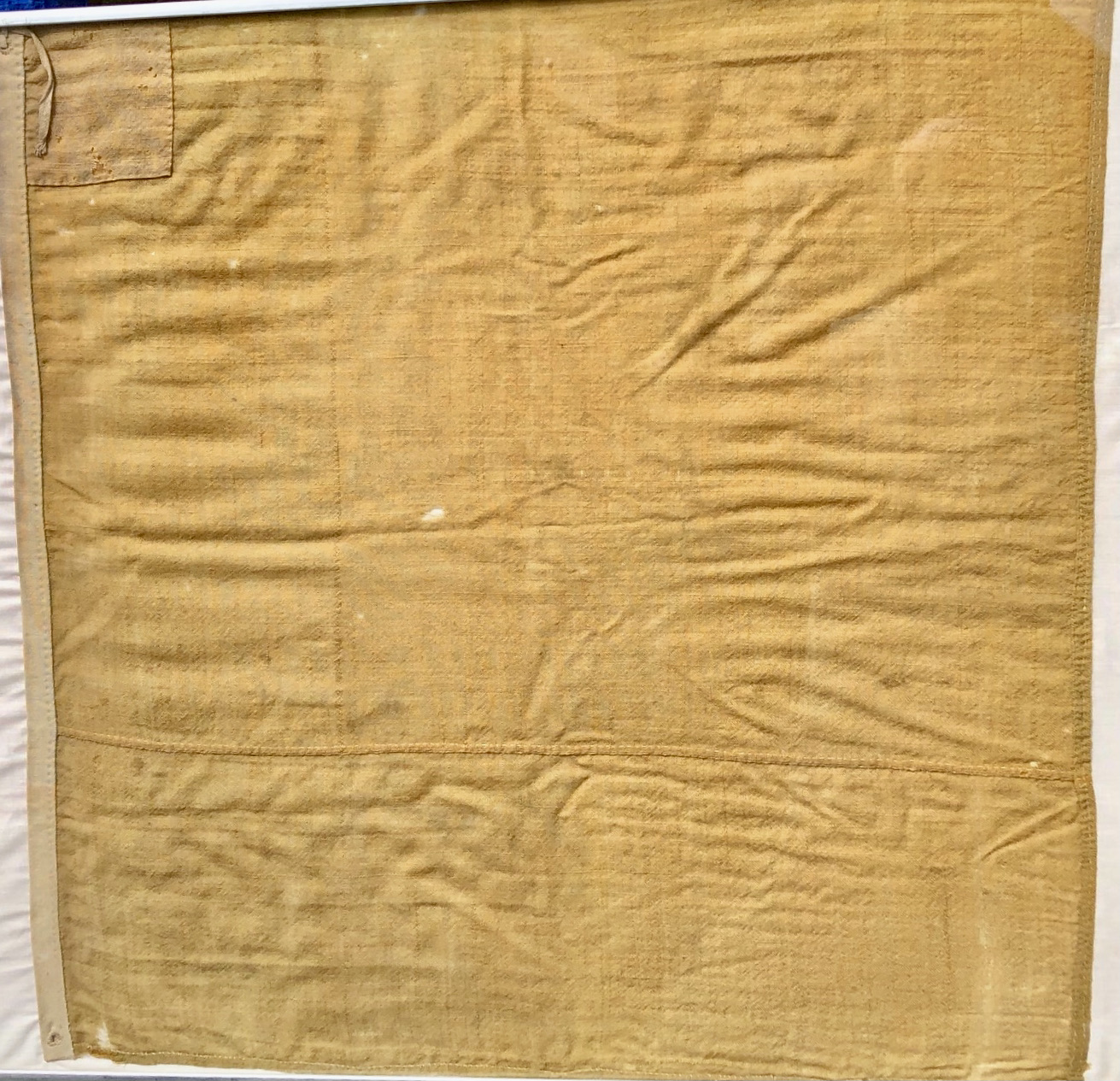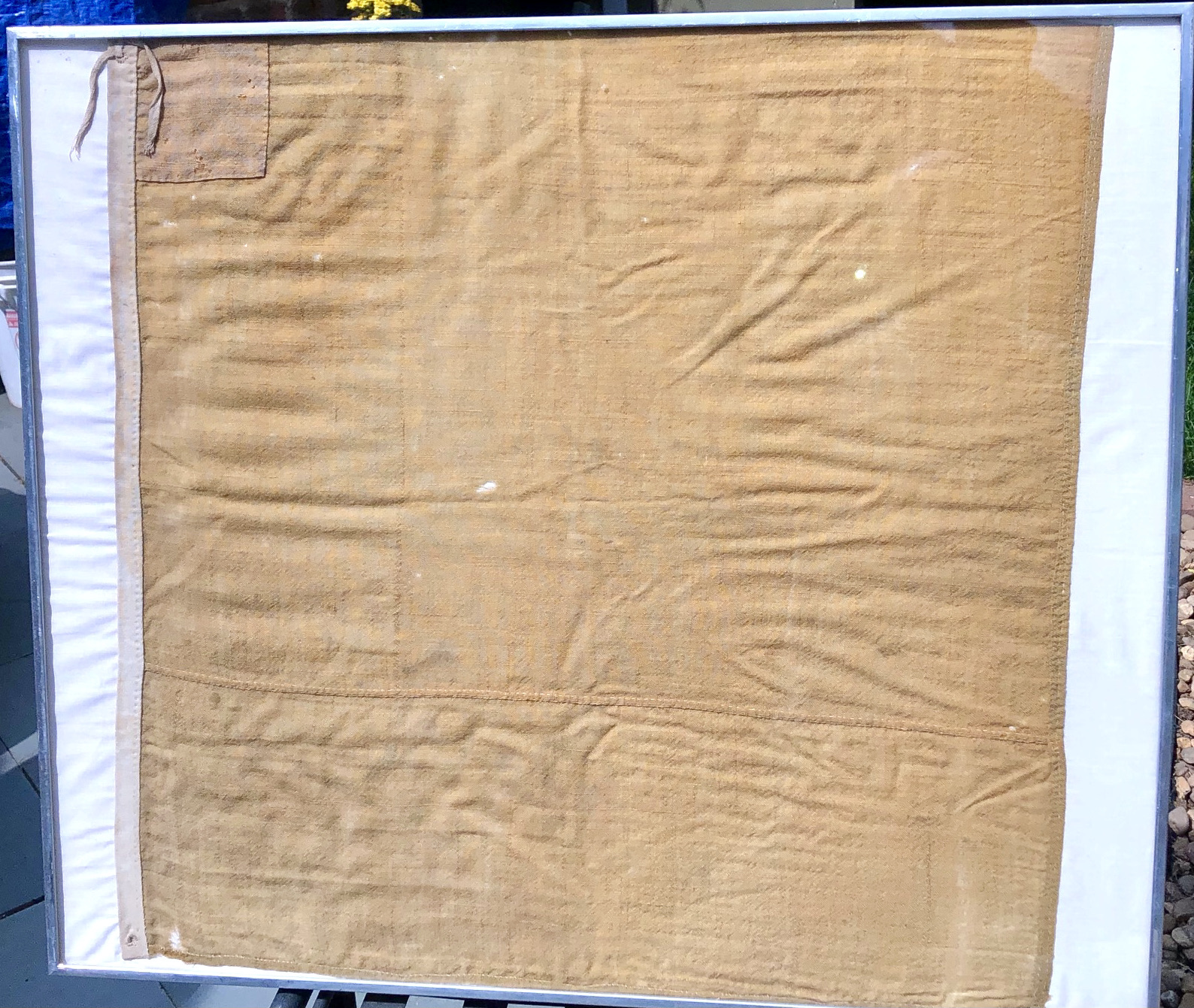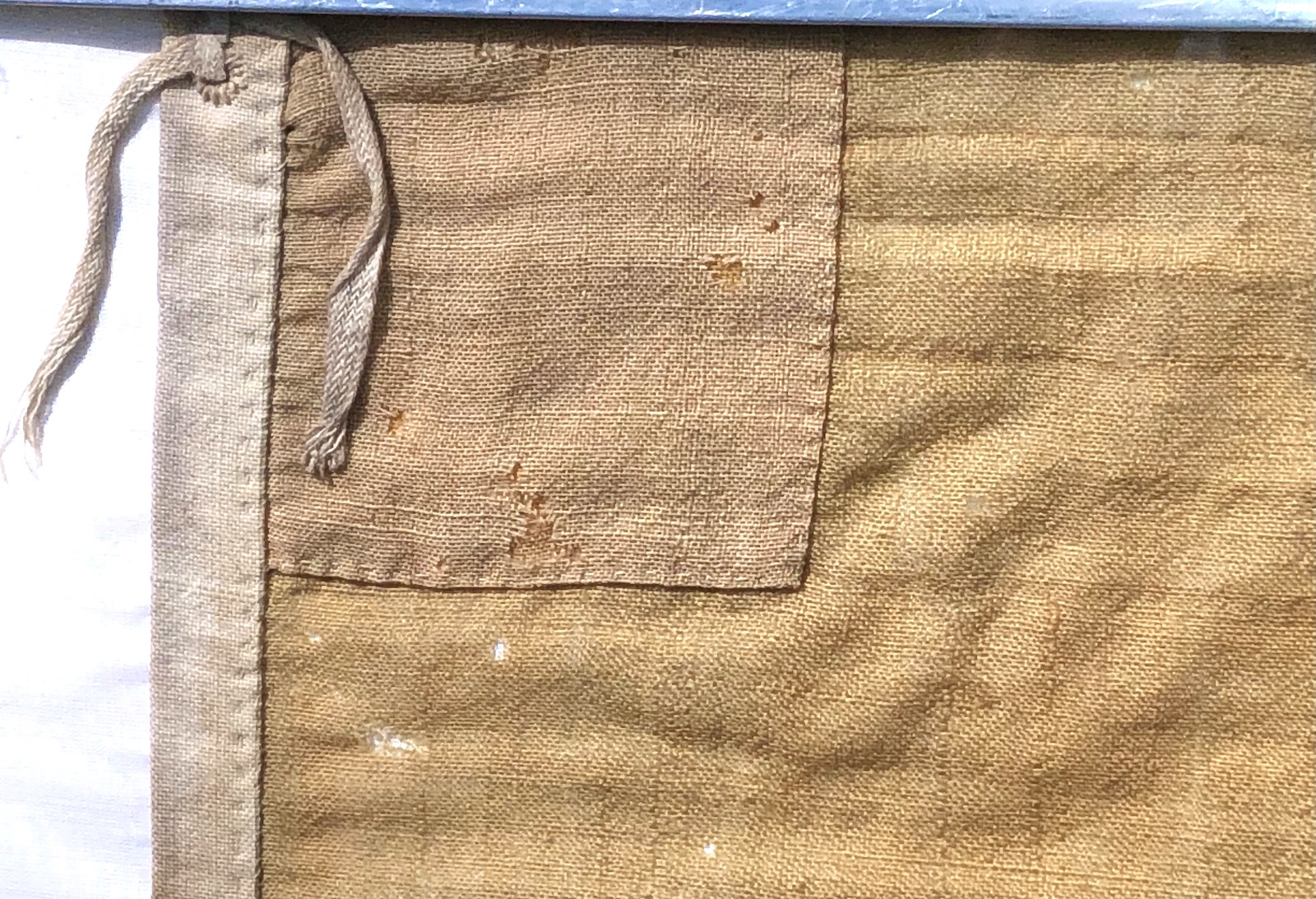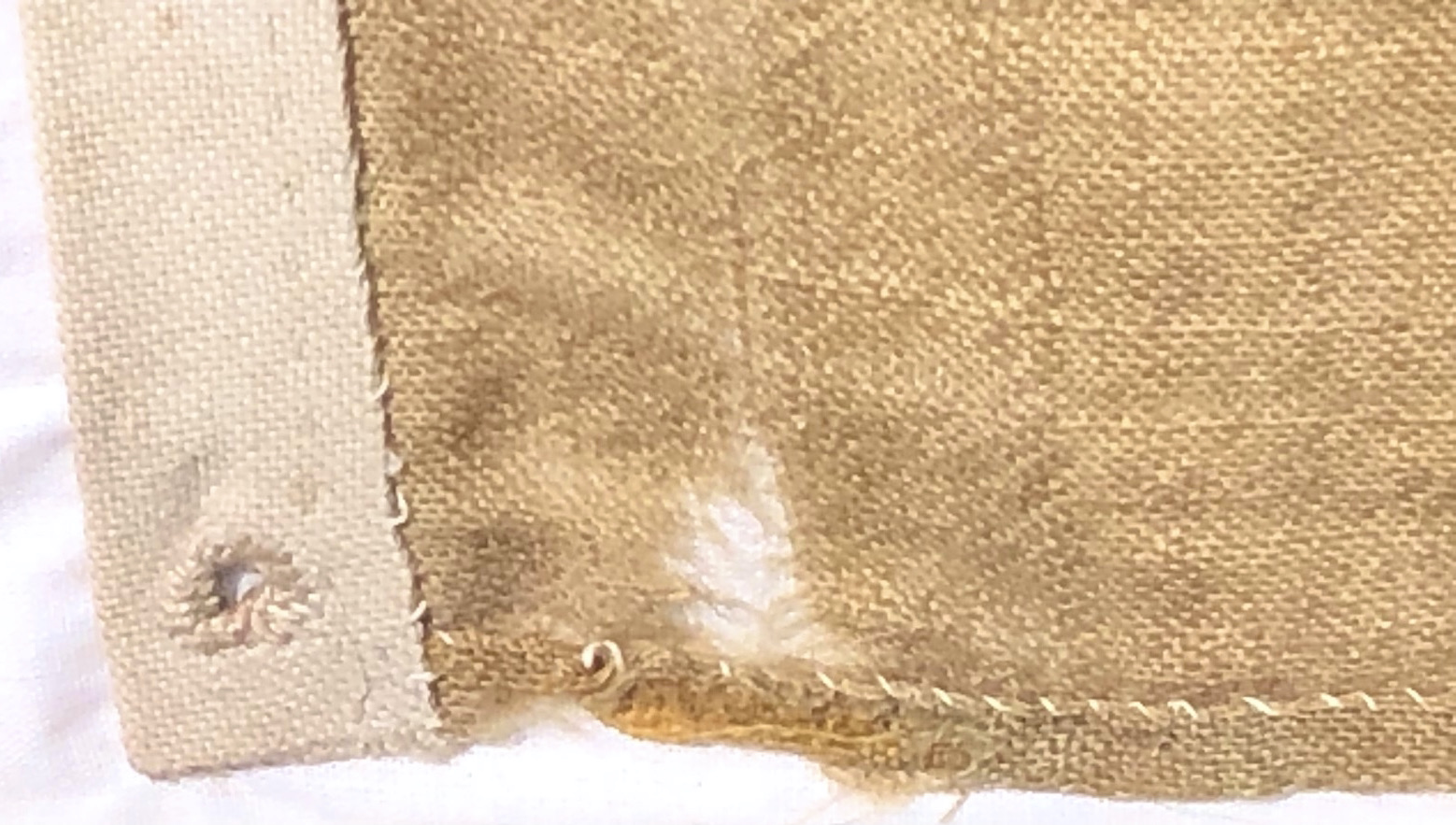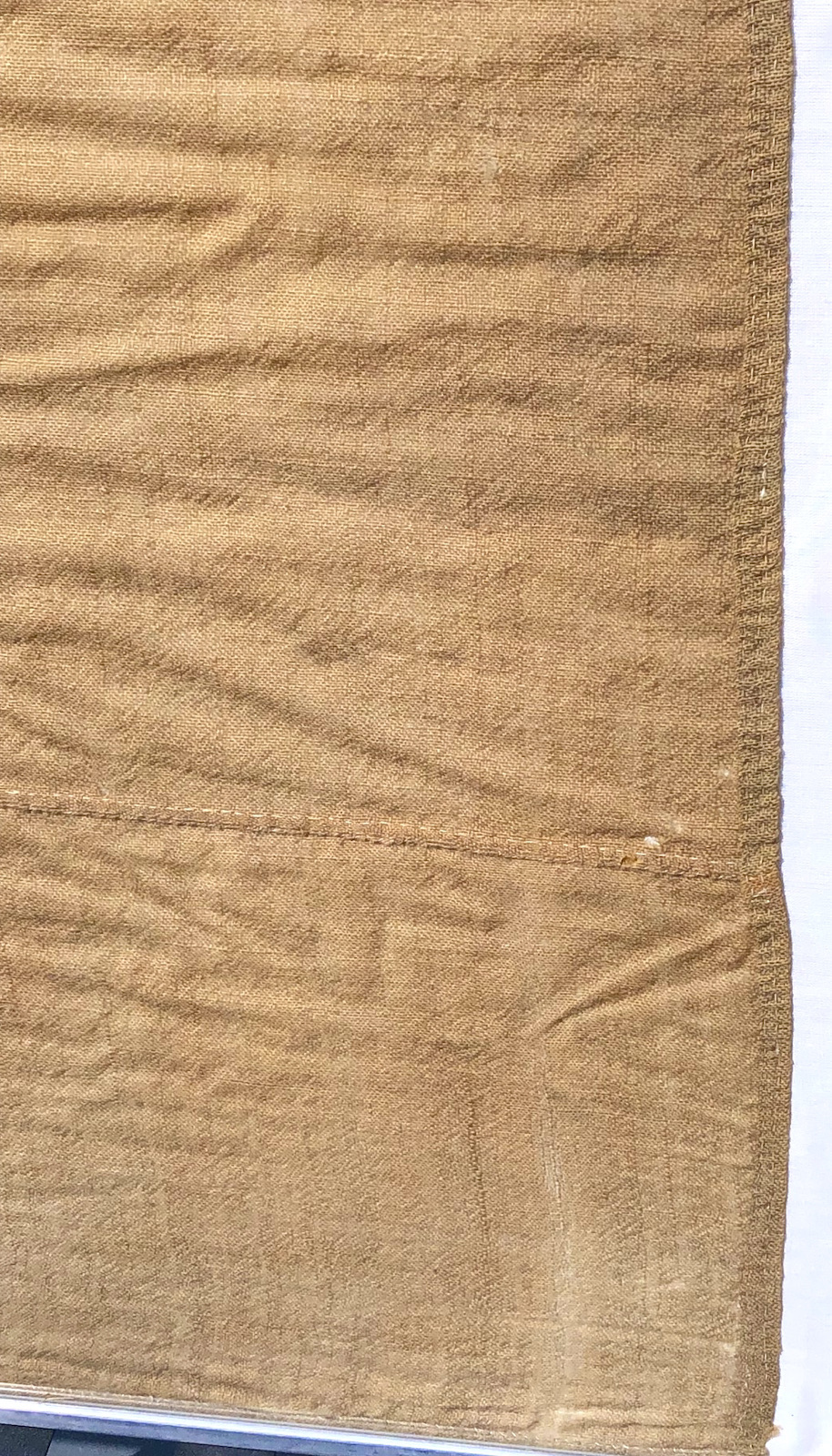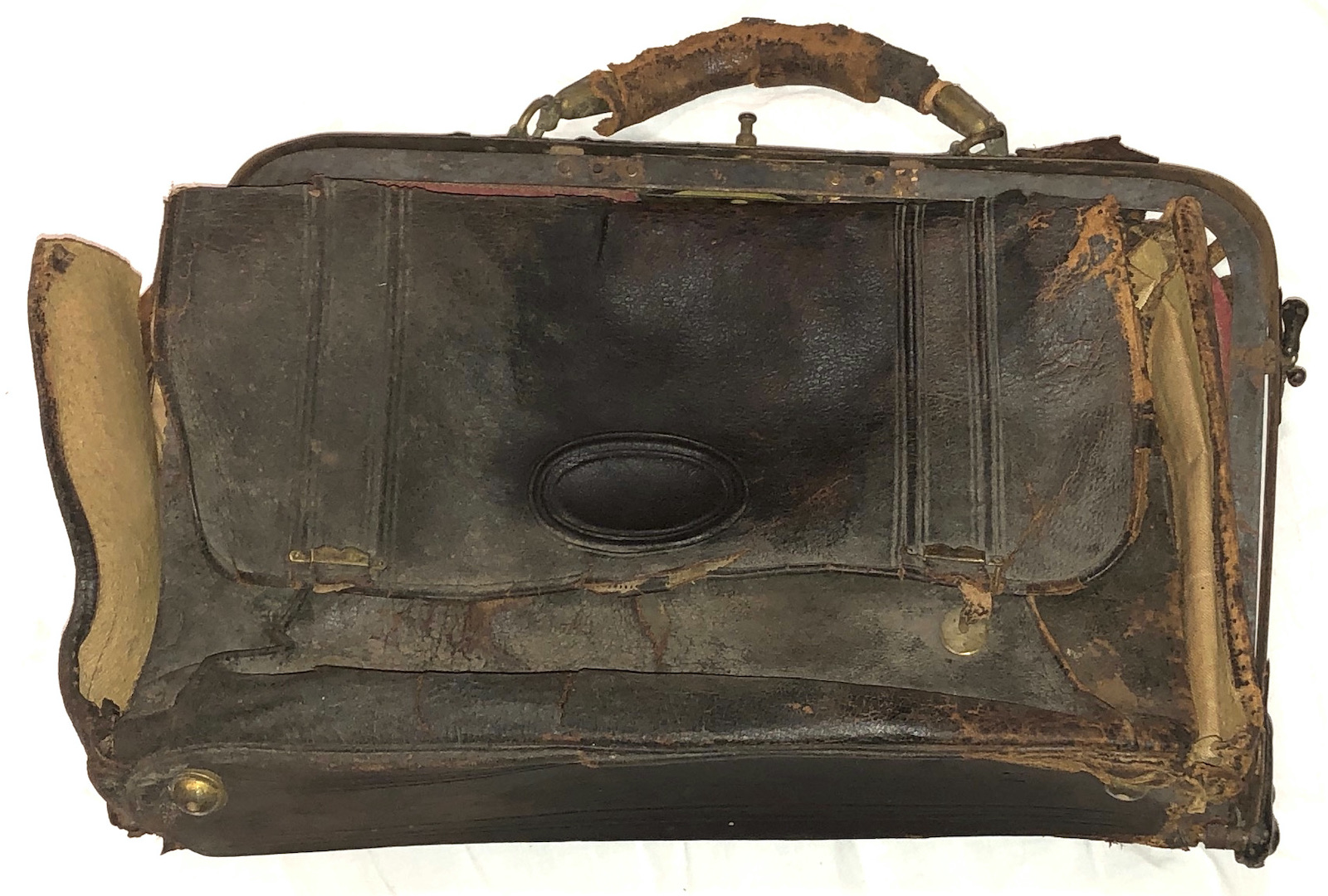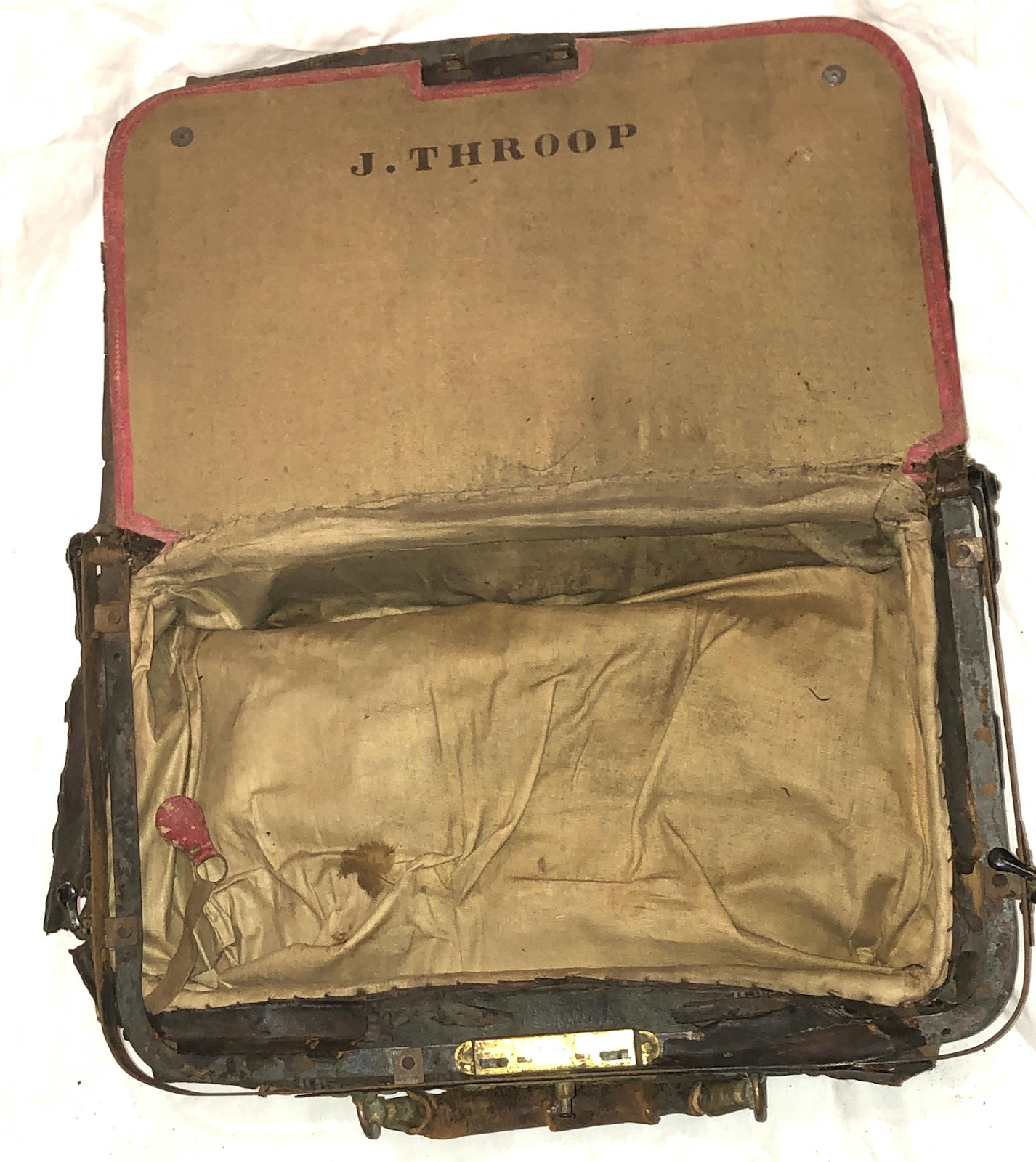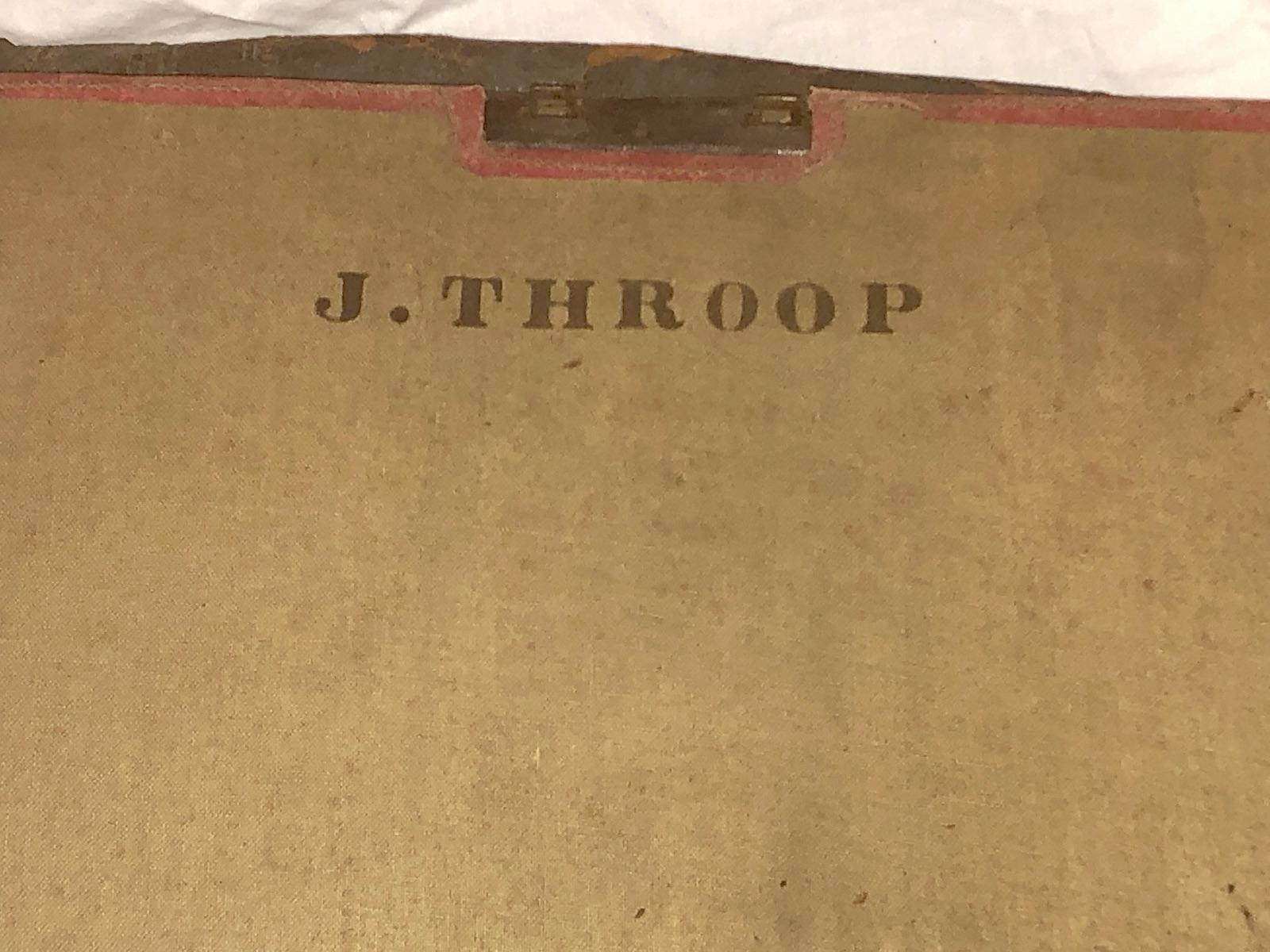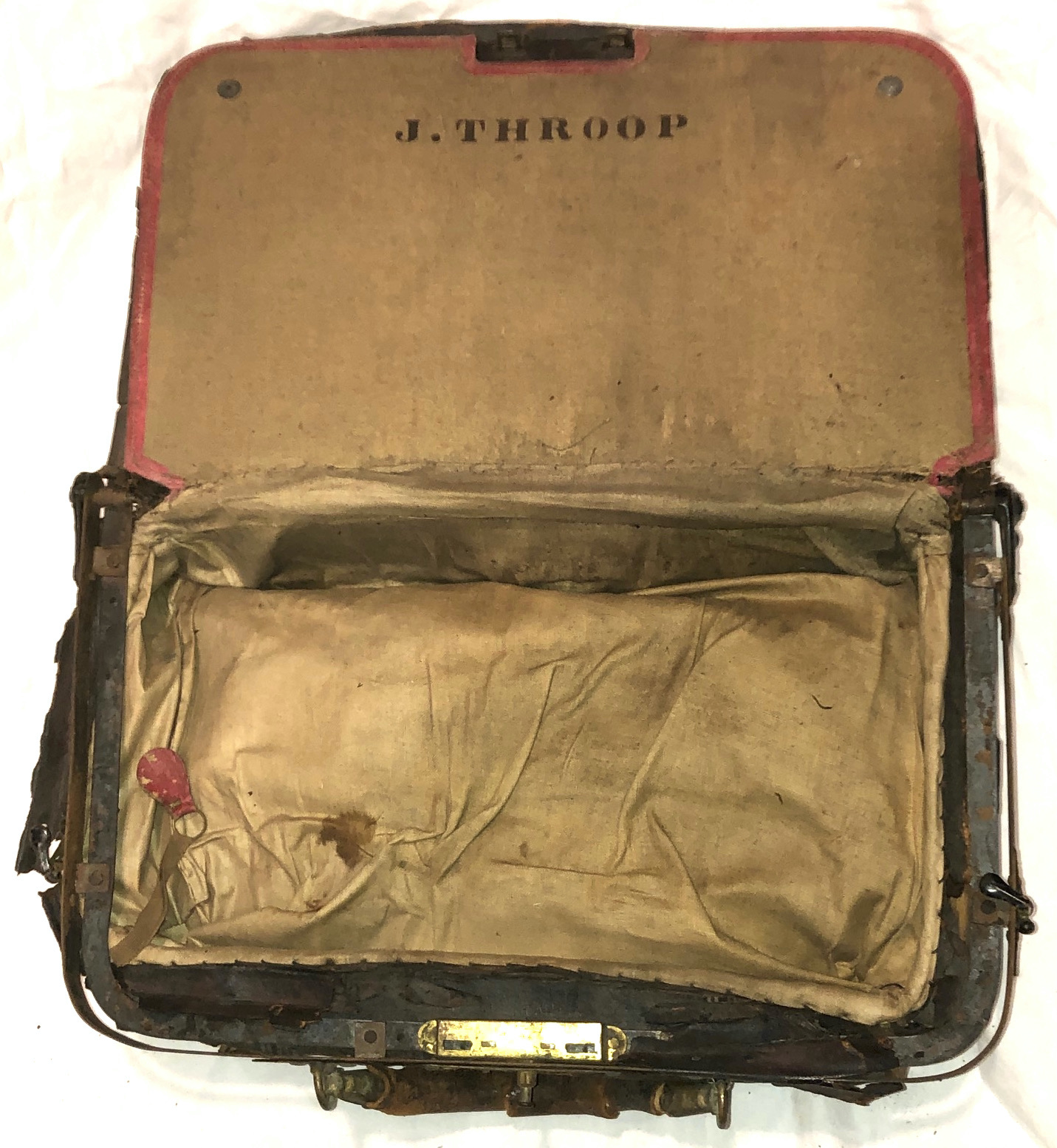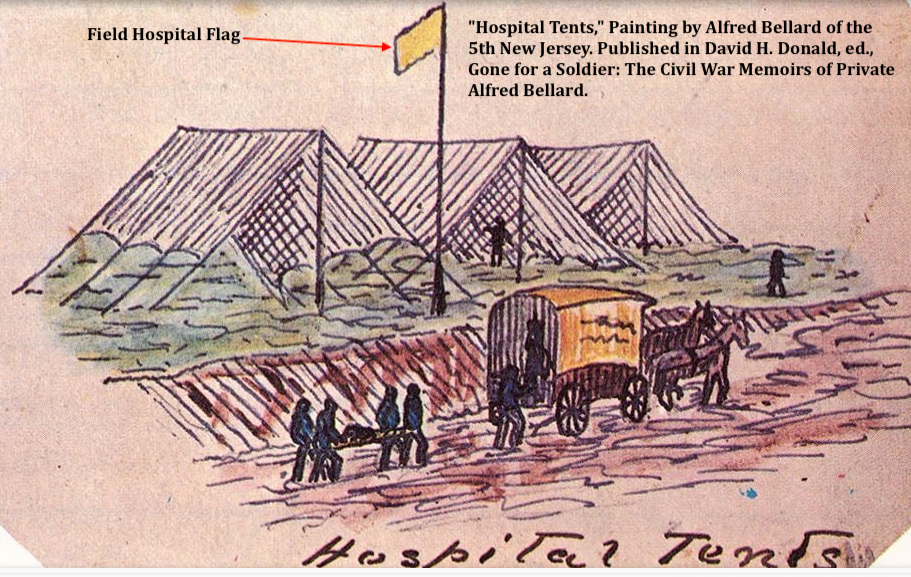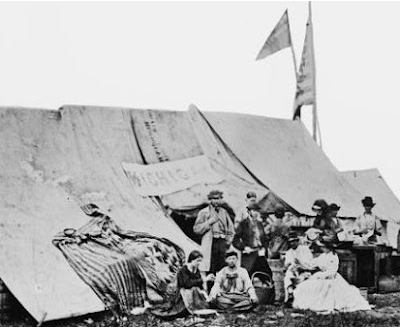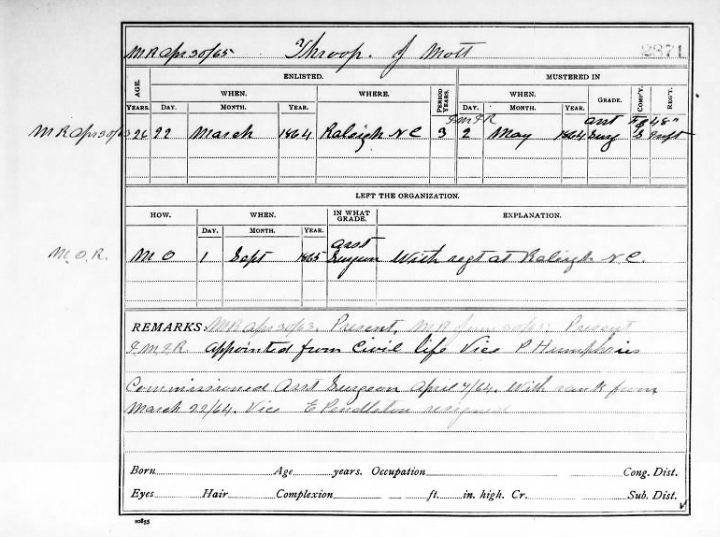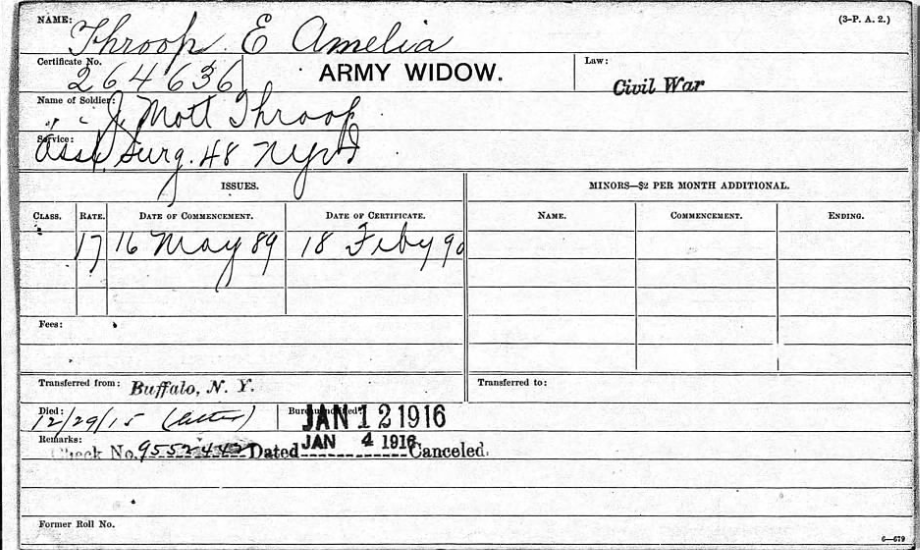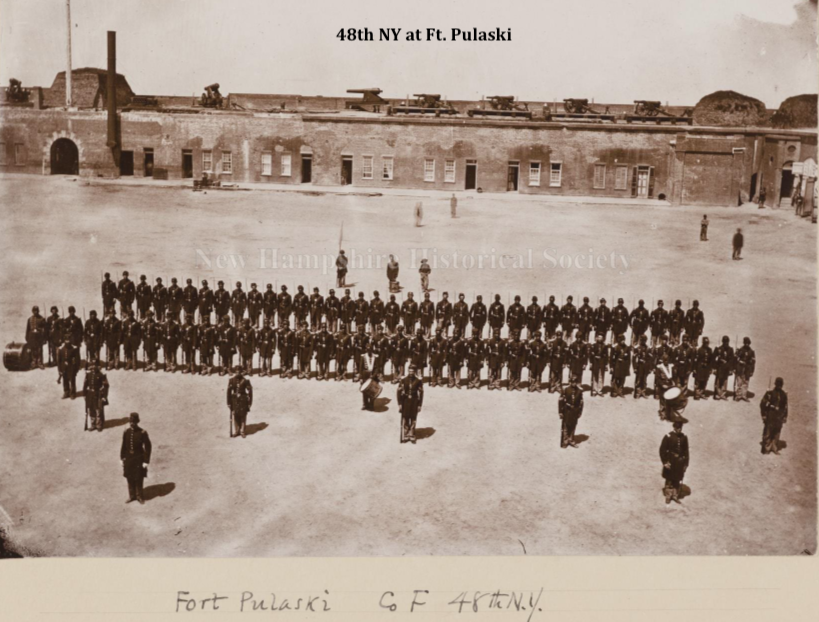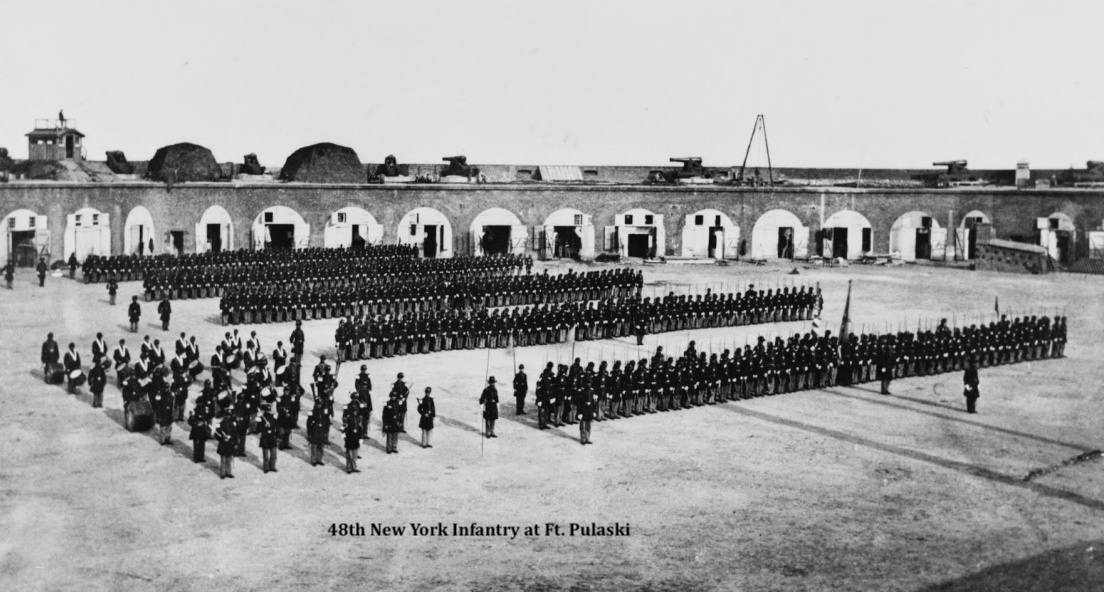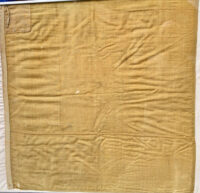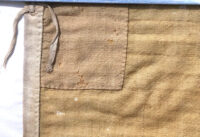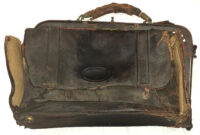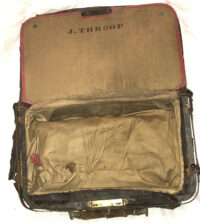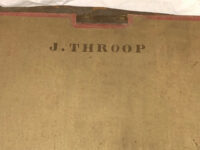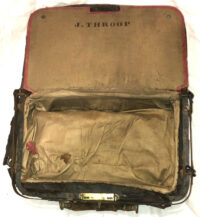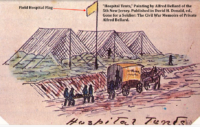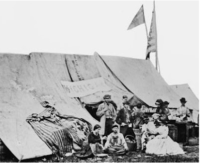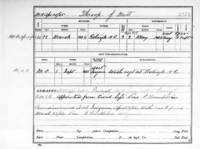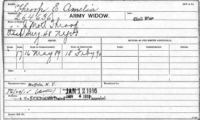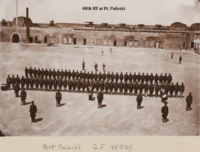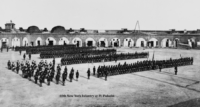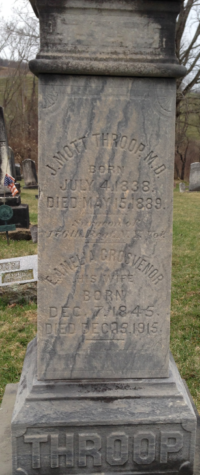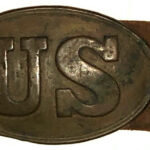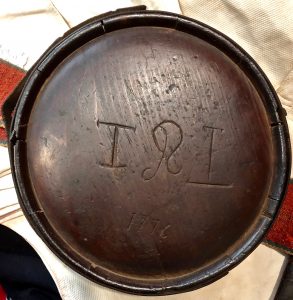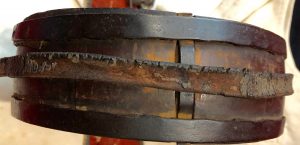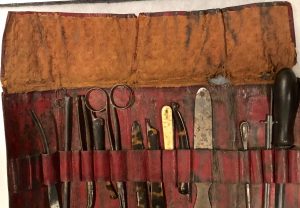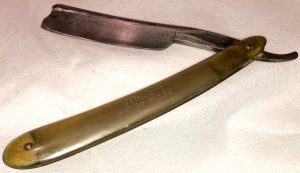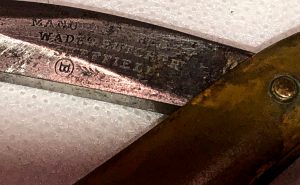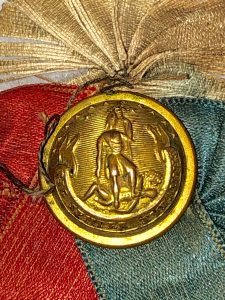U.S. 1863 Regulation Field Hospital or Ambulance Depot Flag and Surgeon’s Valise of Asst. Surgeon J. Mott Throop 48th New York Infantry
SOLD
U.S. 1863 Regulation Field Hospital or Ambulance Depot Flag and Surgeon’s Valise of Asst. Surgeon J. Mott Throop 48th New York Infantry – When initially found, this surgeon’s, well-worn valise, contained a folded and somewhat faded, rare, 1863 Regulation, U.S. Hospital flag. Stenciled inside the valise is the name “J. Throop”; Dr. Throop enlisted, as an assistant surgeon, in the 48th New York Infantry on March 22, 1864, remaining in service until September, 1865. Surgeon Throop would see action, with his regiment, at the Battles of Olustee, Port Walthall, Cold Harbor, Petersburg (to include action during the Battle of the Crater) and the assault on the Confederate Ft. Harrison.
At the time of the onset of the Civil War, there was no prescribed design, size, or material for hospital flags. At first, both sides used simple red or yellow rectangles. Army of the Potomac March 24, 1862, General Orders No. 102 reads: The Hospitals will be distinguished by a yellow flag. Department of the Rappahannock June 19, 1863, General Orders No. 53 Repeated General Orders No. 102 Army of the Potomac. Army of the Cumberland/Department of the Cumberland December 19, 1862, General Orders No. 91 Hospital and Ambulance read: Depots will be distinguished by a yellow flag, 3 feet square for the hospitals and for the principal ambulance depot on the field of battle 2 feet square. The same order was repeated on April 25, 1863, by the Department of the Cumberland. And finally, Adjutant General’s Office, War Department January 4, 1864, General Orders No. 9 reads: Hospitals will be distinguished by yellow flags with a green “H” in their centers, larger for General Hospitals, SMALLER FOR FIELD HOSPITALS. A smaller yellow flag bordered with green for ambulances. Army of the Cumberland and the Department of the Gulf April 26, 1864, says: Field and General Hospitals flags will conform to the General Orders No. 62 announced by the War Department.
Also found in the valise was a booklet entitled: “Transactions of the Medical Society of the State of New York at the Annual Meeting in the City of Albany, Held on February, 1854”. While the valise exhibits considerable wear and use, the flag remains in excellent condition; it is constructed of a yellow wool, with a cotton hoist; on the hoist are two hand-whipped grommet holes, one still containing a cotton strand to attach to a pole. We have chosen to pressure mount the flag, for now, as a means of conservation. This is an extremely rare flag, as only a few are in existence today. The valise is in heavily used condition and is somewhat fragile.
The flag measures about 24” x 24” (regulation size); the valise measures approximately: 17” x 10”.
Mott J. Throop
| Residence was not listed; 26 years old. Enlisted on 3/22/1864 at Raleigh, NC as a Asst Surgeon. On 5/2/1864 he was commissioned into Field & Staff NY 48th Infantry He was Mustered Out on 9/1/1865 at Raleigh, NC |
| NAME: | J Mott Throop |
| PUBLICATION YEAR: | 1862 |
| PUBLICATION PLACE: | New York |
| SCHOOL NAME: | University of the City of New York |
| RESIDENCE PLACE: | New York |
| NAME: | Mott J Throop |
| GENDER: | Male
|
|
UNIT: |
Con Surg Us Vols.; Asst Surg 176. N.y. Inf; Asst. Surg 48. N.Y. Inf |
| FILING DATE: | 13 Apr 1889 |
| FILING PLACE: | New York, USA |
| RELATION TO HEAD: | Soldier |
| SPOUSE: | E Amelia Throop |
| NAME: | J. Mott Throop |
| SIDE: | Union |
| REGIMENT STATE/ORIGIN: | New York |
| REGIMENT: | 176th Regiment, New York Infantry |
| COMPANY: | F&S |
| RANK IN: | Assistant Surgeon |
| RANK OUT: | Assistant Surgeon |
| NAME: | J Mott Thorp |
| AGE: | 24 |
| BIRTH YEAR: | 1839 |
| BIRTH PLACE: | New York |
| ENLISTMENT YEAR: | 1862 |
| ENLISTMENT LOCATION: | New York City, USA |
| MUSTER YEAR: | 1863 |
| MUSTER REGIMENT: | 176th Infantry |
| SEPARATION DATE: | 16 Nov 1863 |
| SEPARATION DETAILS: | Mustered Out |
| NAME: | Mott J Throop |
| ENLISTMENT AGE: | 26 |
| BIRTH DATE: | 1838 |
| ENLISTMENT DATE: | 22 Mar 1864 |
| ENLISTMENT PLACE: | Raleigh, North Carolina |
| ENLISTMENT RANK: | Assistant Surgeon |
| MUSTER DATE: | 2 May 1864 |
| MUSTER PLACE: | New York |
| MUSTER COMPANY: | S |
| MUSTER REGIMENT: | 48th Infantry |
| MUSTER REGIMENT TYPE: | Infantry |
| MUSTER INFORMATION: | Commission |
| MUSTER OUT DATE: | 1 Sep 1865 |
| MUSTER OUT PLACE: | Raleigh, North Carolina |
| MUSTER OUT INFORMATION: | Mustered Out |
| SIDE OF WAR: | Union |
| SURVIVED WAR?: | Yes |
| WAS OFFICER?: | Yes |
Dr James Mott Throop
BIRTH
4 Jul 1838
Hubbardsville, Madison County, New York, USA
DEATH
15 May 1889 (aged 50)
Lebanon, Madison County, New York, USA
BURIAL
Lebanon, Madison County, New York, USA
Civil War Hospital Flags
By Jack Thomason
The US Army regulations (1854) called for a red flag for hospitals at the beginning of the war, dating back to the reorganization of Amy soon after the War with Mexico. Red flags were used, starting with the French Army in the 1700’s and later on in England. General Beauregard issued orders that red flags were to be used to mark the locations of Hospitals, of the Confederate Army of the Potomac. It appears that General Beauregard copied the U.S Army regulations of 1854. Several late war captured red Confederate Hospital flags survive.
The yellow quarantine flag was adopted, per Act of Congress, in 1798 to mark the locations of the “Marine Hospital Service” (Government run) Hospitals. The yellow quarantine flag was first used by the City of Philadelphia in 1699 to mark the locations of sick seamen under the maritime quarantine laws. In 1860 there were nineteen “Marine Hospital Service” hospitals along the eastern cost and several others along the Gulf of Mexico cost. At the beginning of the war those hospitals were taken over for military use in the north and south. The U.S. Army did not adopt the yellow hospital flag until 1862, General Orders 102, Army of the Potomac. The Department of the Rappahannock in 1863, General orders 53. The Department of the Cumberland as with the Army of Ohio later in 1863 adopted the yellow flag for hospitals. The Army of the West replaced the red flag for hospitals with an U.S. National flag in early 64. Later in 64 they conformed to an Act of Congress of the yellow flag with the green H.
The U.S. Hospital Department, the U.S. Medical Service and the Ambulance Department were separate departments and had deferent regulation regarding flags and the deferent departments had their own hospitals. In most cases the word hospital refers to the larger general hospitals in larger cities & towns, field hospitals located near the battle field and aid stations or ambulance depots located at the rear of the army on the field of battle.
The yellow flag shows up very early for Confederate hospitals regardless of the orders from General Beauregard. Many of those hospitals were run by civilian doctors so, I guess, Army regulations didn’t apply. As with the U.S. Army, the Confederate Medical Service and the Ambulance Department were deferent departments. The Ambulance Department pretty much followed orders on the use of red flags for their field hospitals and depots, while the Medical Department used yellow flags; they had more civilian doctors then the Ambulance Department. It is documented that in fairly safe areas, Hospitals were usually just marked by a national flag, both north and south. There is supported data that the Confederate Army used red and white flags to ID their Ambulance trains. There is also data that the U.S. Army used small Corps flags bordered in green on their Ambulance trains. By trains, I mean both the coal powered ones and the horse powered ones.
On the regimental level, both north & south, both color flags were used to mark aid stations. For more documentation on the use of yellow flags at this level of medical care for the troops.
Both Union and Confederate armies used bright red or yellow flags to designate field hospitals, enabling stretcher-bearers and ambulance drivers to easily locate them behind the front lines.
In January 1864, the U.S. Army issued formal regulations for yellow hospital flags, specifying a contrasting green “H” for “Hospital.” Larger flags of the same design marked the location of 200 permanent hospitals in cities and towns.
At the time of the Civil War, there was no prescribed design, size, or material for hospital flags. At first, both sides used simple red or yellow rectangles. Army of the Potomac March 24, 1862, General Orders No. 102 reads: The Hospitals will be distinguished by a yellow flag. Department of the Rappahannock June 19, 1863, General Orders No. 53 Repeated General Orders No. 102 Army of the Potomac. Army of the Cumberland/Department of the Cumberland December 19, 1862, General Orders No. 91 Hospital and Ambulance read: Depots will be distinguished by a yellow flag, 3 feet square for the hospitals and for the principal ambulance depot on the field of battle 2 feet square. The same order was repeated on April 25, 1863, by the Department of the Cumberland. And finally, Adjutant General’s Office, War Department January 4, 1864, General Orders No. 9 reads: Hospitals will be distinguished by yellow flags with a green “H” in their centers, larger for General Hospitals, SMALLER FOR FIELD HOSPITALS. A smaller yellow flag bordered with green for ambulances. Army of the Cumberland and the Department of the Gulf April 26, 1864, says: Field and General Hospitals flags will conform to the General Orders No. 62 announced by the War Department.
So, prior to General Order No. 9 of January 4, 1864, a solid yellow flag was used to designate the hospitals. With GO 9, the following sizes were established: General Hospital Flag: 9 ft X 5 ft with a 24-inch tall green “H”. Post and Field Hospital Flag: 6 ft X 4 ft with a 24-inch tall green “H”. Ambulance and Guidon Flags: 14 inches X 28 inches with a 1-inch green border. The guidon flags “lead” the way to the field hospitals.
48th NY Infantry
( 3-years )
| Organized: Brooklyn, NY on 9/1/61 Mustered Out: 9/1/65 at Raleigh, NCOfficers Killed or Mortally Wounded: 18 Officers Died of Disease, Accidents, etc.: 2 Enlisted Men Killed or Mortally Wounded: 218 Enlisted Men Died of Disease, Accidents, etc.: 131 (Source: Fox, Regimental Losses) |
| From | To | Brigade | Division | Corps | Army | Comment |
| Oct ’61 | Apr ’62 | 1 | South Carolina Expeditionary Corps | |||
| Apr ’62 | Sep ’62 | Fort Pulaski, GA | Department of the South | |||
| Sep ’62 | Jun ’63 | Fort Pulaski, GA | 10 | Department of the South | ||
| Jun ’63 | Jul ’63 | US Forces, St Helena Is. | Department of the South | |||
| Jul ’63 | Jul ’63 | 2 | US Forces, Folly Island | Department of the South | ||
| Jul ’63 | Jul ’63 | 2 | 2 | 10 | Department of the South | |
| Jul ’63 | Jul ’63 | 1 | US Forces, Morris Island | 10 | Department of the South | |
| Aug ’63 | Oct ’63 | St. Augustine, FL | 10 | Department of the South | ||
| Nov ’63 | Dec ’63 | US Forces, Hilton Head | 10 | Department of the South | ||
| Dec ’63 | Feb ’64 | Barton’s | US Forces, Hilton Head | 10 | Department of the South | |
| Feb ’64 | Feb ’64 | Barton’s | Dist of Florida | Department of the South | ||
| Feb ’64 | Apr ’64 | Barton’s | 1 | Dist of Florida | Department of the South | |
| Apr ’64 | May ’64 | 2 | 2 | 10 | Army of the James | |
| May ’64 | Jun ’64 | 1 | 3 | 18 | Army of the James | |
| Jun ’64 | Dec ’64 | 2 | 2 | 10 | Army of the James | |
| Dec ’64 | Jan ’65 | 2 | 2 | 24 | Army of the James | |
| Jan ’65 | Mar ’65 | 2 | 2 | Terry’s Provisional | Department of North Carolina | |
| Mar ’65 | Aug ’65 | 2 | 2 | 10 | Department of North Carolina | Mustered Out |
NEW YORK
FORTY-EIGHTH INFANTRY
(Three Years)
|
Forty-eighth Infantry.-Cols., James H. Perry, William B. Barton, William B. Coan; Lieut.-Cols., William B. Barton, Oliver F. Beard, James F. Green, Dudley W. Strickland, William B. Coan, Nere A. Elfwing; Majs., Oliver F. Beard, James F. Greene, Dudley W. Strickland, William B. Coan, Samuel M. Swartwout, Nere A. Elfwing, Albert F. Miller, James A. Barrett.
The 48th, the “Continental Guard,” contained seven Brooklyn companies, one from New York, one from Monmouth county, N. J., and one from Brooklyn and Monmouth county. It was mustered into the U. S. service at Brooklyn Aug. 16 to Sept. 14, 1861, for three years; left the state for Washington Sept. 16; was attached to the 1st brigade of Gen. Sherman’s force; embarked for Port Royal late in October, and was active in the capture of the fortifications of Port Royal ferry Jan. 1, 1862.
In the siege operations against Fort Pulaski, Ga., the 48th took a prominent part and after the fall of the fortress was assigned to garrison duty there with expeditions in September and October to Bluffton, Cranston’s bluff and Mackay’s point. In June, 1863, the regiment with the exception of Cos. G and I, left Fort Pulaski and proceeded to Hilton Head, where it was there attached to Strong’s brigade, 10th corps, with which it participated in the movement against Fort Wagner in July.
In the assault of July 18, the loss of the 48th was 242 killed, wounded and missing, including Col. Barton wounded and Lieut.- Col. Green killed. The regiment received high praise from the commanding officers for its gallantry in this action. In August it formed a part of the Florida expedition; was posted for some time at St. Augustine; participated in the disastrous battle at Olustee, with a loss of 44 in killed, wounded and missing; then retired to Jacksonville; proceeded up the river to Palatka on March 10, 1864, remained there until April when it was transferred to the Army of the James at Bermuda Hundred, and was assigned to the 2nd brigade, 2nd division, 10th corps.
In the engagement at Port Walthall Junction the regiment again showed its mettle by heroic conduct in spite of severe loss. On May 30 it was assigned to the 1st brigade, 3d division, 18th corps, and on June 15, to the 2nd brigade, 2nd division, 10th corps. It took a prominent part in the battle of Cold Harbor; was in the first assault on Petersburg and in action at the explosion of the mine; and was engaged at Strawberry Plains and Fort Harrison.
The original members not reenlisted were mustered out at New York city on Sept. 24, 1864, but 350 members having reenlisted in Dec., 1863, the regiment retained its organization. In Dec., 1864, with the 2nd brigade, 2nd division, 24th corps, the 48th was ordered to Fort Fisher, N. C., was active in the capture of the fortifications there in Jan.,1865, and served for some months in that vicinity.
In March it was attached to the provisional corps, in April to the 10th corps and during the summer months performed various routine duties in the neighborhood of Raleigh, N. C., where it was finally mustered out on Sept. 1, 1865. During its term of service 2,173 members were enrolled, and of these 236 or over 10 per cent, were killed or mortally wounded in action, a loss exceeded among the regiments of the state only by the 69th and 40th.
It was 17th in the list of all of the regiments of the Union armies in total loss. In the battles of the regiment 868 men were reported killed, wounded or missing, and it earned by desperate fighting its right to be known as a crack fighting regiment. |
48th New York Infantry Regiment
| 48th New York Infantry Regiment | |
| Active | September 10, 1861, to August 16, 1865 |
| Country | United States |
| Allegiance | Union |
| Branch | Infantry |
| Nickname(s) | Continental Guard |
| Engagements | Siege of Fort Pulaski Battle of Secessionville Second Battle of Fort Wagner Second Battle of Charleston Harbor Battle of Olustee Battle of Cold Harbor Bermuda Hundred Campaign Battle of Port Walthall Junction Battle of Cold Harbor Siege of Petersburg Battle of the Crater Second Battle of Deep Bottom Battle of Chaffin’s Farm First Battle of Fort Fisher Second Battle of Fort Fisher Carolinas Campaign Battle of Wilmington |
The 48th New York Infantry Regiment was an infantry regiment in the Union Army during the American Civil War.
Service
The 48th New York Infantry was organized at Brooklyn, New York and mustered in for three years service on September 10, 1861, under the command of Colonel James H. Perry.
The regiment was attached to Viele’s 1st Brigade, Sherman’s South Carolina Expeditionary Corps, to April 1862. Fort Pulaski, Georgia, X Corps, Department of the South, to May 1863. St. Helena Island, South Carolina, X Corps, to June 1863. 2nd Brigade, Folly Island, South Carolina, to July 1863. 2nd Brigade, 2nd Division, Morris Island, South Carolina, to August 1863. St. Augustine, Florida, to October 1863. District of Hilton Head, South Carolina, to January 1864. Barton’s Brigade, District of Hilton Head, South Carolina, to February 1864. Barton’s Brigade, District of Florida, February 1864. Barton’s Brigade, Ames’ Division, District of Florida, to April 1864. 2nd Brigade, 2nd Division, X Corps, Army of the James, Department of Virginia and North Carolina, to May 1864. 1st Brigade, 3rd Division, XVIII Corps, to June 1864. 2nd Brigade, 2nd Division, X Corps, to December 1864. 2nd Brigade, 2nd Division, XXIV Corps, to January 1865. 2nd Brigade, 2nd Division, Terry’s Provisional Corps, Department of North Carolina, to March 1865. 2nd Brigade, 2nd Division, X Corps, Department of North Carolina, to July 1865. Department of North Carolina to August 1865.[1]
The 48th New York Infantry mustered out of service on August 16, 1865.
Detailed service
The 48th, the “Continental Guard,” contained seven Brooklyn companies, one from New York, one from Monmouth County, N. J., and one from Brooklyn and Monmouth county. It was mustered into the U. S. service at Brooklyn Aug. 16 to Sept. 14, 1861, for three years; left the state for Washington Sept. 16; was attached to the 1st brigade of Gen. Sherman’s force; embarked for Port Royal late in October, and was active in the capture of the fortifications of Port Royal ferry Jan. 1, 1862. In the siege operations against Fort Pulaski, Ga., the 48th took a prominent part and after the fall of the fortress was assigned to garrison duty there with expeditions in September and October to Bluffton, Cranston’s Bluff and Mackay’s Point. In June, 1863, the regiment with the exception of Cos. G and I, left Fort Pulaski and proceeded to Hilton Head, where it was there attached to Strong’s Brigade, 10th Corps, with which it participated in the movement against Fort Wagner in July. In the assault of July 18, the loss of the 48th was 242 killed, wounded and missing, including Col. Barton wounded and Lieut.-Col. Green killed. The regiment received high praise from the commanding officers for its gallantry in this action. In August it formed a part of the Florida expedition; was posted for some time at St. Augustine; participated in the disastrous battle at Olustee, with a loss of 44 in killed, wounded and missing; then retired to Jacksonville; proceeded up the river to Palatka on March 10, 1864, remained there until April when it was transferred to the Army of the James at Bermuda Hundred, and was assigned to the 2nd Brigade, 2nd Division, 10th Corps. In the engagement at Port Walthall Junction the regiment again showed its mettle by heroic conduct in spite of severe loss. On May 30 it was assigned to the 1st Brigade, 3rd Division, 18th Corps, and on June 15, to the 2nd Brigade, 2nd Division, 10th Corps. It took a prominent part in the battle of Cold Harbor; was in the first assault on Petersburg and in action at the explosion of the mine; and was engaged at Strawberry Plains and Fort Harrison. The original members not reenlisted were mustered out at New York City on Sept. 24, 1864, but 350 members having reenlisted in Dec., 1863, the regiment retained its organization. In Dec., 1864, with the 2nd Brigade, 2nd Division, 24th Corps, the 48th was ordered to Fort Fisher, N. C., was active in the capture of the fortifications there in Jan., 1865, and served for some months in that vicinity. In March it was attached to the provisional corps, in April to the 10th Corps and during the summer months performed various routine duties in the neighborhood of Raleigh, N. C., where it was finally mustered out on Sept. 1, 1865. During its term of service 2,173 members were enrolled, and of these 236 or over 10 percent, were killed or mortally wounded in action, a loss exceeded among the regiments of the state only by the 69th and 40th. It was 17th in the list of all of the regiments of the Union armies in total loss. In the battles of the regiment 868 men were reported killed, wounded or missing, and it earned by desperate fighting its right to be known as a crack fighting regiment.[2]
Casualties
The regiment lost a total of 369 men during service; 18 officers and 218 enlisted men killed or mortally wounded, 2 officers and 131 enlisted men died of disease.
Commanders
- Colonel James H. Perry – died in the service, June 18, 1862
- Colonel William B. Barton
- Colonel William B. Coan
48th New York Volunteer Infantry Regiment
“Continental Guard”
“Perry’s Saints”
The 48th New York Volunteer Infantry lost 18 officers and 218 enlisted men killed and mortally wounded and 2 officers and 131 enlisted men to disease during the Civil War.
| 1861 | |
| September 10 | Organized at Brooklyn, N.Y. under Colonel James H. Perry, Lieutenant Colonel
William B. Barton and Major Oliver Beard |
| September 17 | Left State for Annapolis, Md. Attached to Viele’s 1st Brigade, Sherman’s South
Carolina Expeditionary Corps |
| October 21-November 7 | Expedition to Port Royal, S.C. |
| November 7 | Capture of Forts Walker and Beauregard, Port Royal Harbor, S.C. |
| November 7-8 | Hilton Head, S.C. |
| 1862 | |
| January 1 | Port Royal Ferry, Coosaw River, S. C. |
| January 28- April 11 |
Siege operations against Fort Pulaski, Ga. |
| April 10-11 | Bombardment and capture of Fort Pulaski |
| April | Garrison duty at Fort Pulaski, 10th Army Corps, Dept. of the South |
| June 18 | Colonel Perry died at Fort Pulaski, Georgia. Lt. Colonel Barton promoted to
colonel, Major Beard to lieutenant colonel, and Captain James Green of Company F to captain |
| August 5 | Tybee Island |
| September 24 | Skull Creek |
| September 30-October 13 | Reconnaissance on May and Savannah Rivers |
| October 18 | Kirk’s Bluff, Coosawhatchie River |
| October 21-23 | Expedition from Hilton Head to Pocotaligo |
| October 22 | Pocotaligo, Coosawhatchie |
| November 7 | Expedition on U.S. Steamers Potomski and Darlington up Sapelo River, and
destruction of salt works |
| December 24 | Lt. Colonel Beard discharged |
| 1863 | |
| January 1 | Major Green promoted to lieutenant colonel and Captain Dudley Strickland of
Company H to major |
| May | Moved to Hilton Head, S.C., then to St. Helena Island, S.C. attached to 10th
Army Corps. Cos. G and I remained at Hilton Head. |
| June | Moved to Folly Island, S. C. attached to 2nd Brigade |
| July | Attached to 2nd Brigade, 2nd Division, Morris Island, S.C. |
| July 10 |
Attack on Morris Island, S. C.Captain Louis Lent and 5 enlisted men were killed and 18 enlisted men wounded. |
| July 11 and 18 |
Assaults on Fort Wagner, Morris IslandLt. Colonel Green, Captains James Farrell, Frederick Hurst and James Panson and 79 enlisted men were killed or mortally wounded, Captains Nere Elfwing and William Lockwood, Lieutenants James Barrett, Albert Miller and Joseph Taylor and 87 enlisted men wounded, and 1 officer and 63 enlisted men missing or captured |
| July 18 to August | Siege of Forts Wagner and Gregg, Morris Island |
| August – October | At St. Augustine, Fla. Companies G and I at Fort Pulaski. |
| September 21 | Major Strickland promoted to lieutenant colonel |
| October | Duty at Hilton Head and Beaufort, S.C. attached to District of Hilton Head, S.C. |
| November 9 | Captain William B. Coan of Company E promoted to major |
| 1864 | |
| January | Attached to Barton’s Brigade, District of Hilton Head, S.C. |
| February 5-7 | Expedition to Jacksonville, Fla. attached to Barton’s Brigade, District of Florida |
| February 8-22 | Expedition into Central Florida attached to Barton’s Brigade, Ames’ Division,
District of Florida |
| February 20 |
Battle of OlusteeThe regiment lost 1 officer and 498 enlisted men killed or mortally wounded, 1 officer and 143 enlisted men wounded and 22 enlisted men captured or missing. |
| March 10 | Occupation of Palatka |
| April 22-28 | Moved to Gloucester Point, Va. attached to 2nd Brigade, 2nd Division, 10th
Army Corps, Army of the James, Dept. of Virginia and North Carolina |
| May 4-28 | Butler’s operations on south side of the James and against Petersburg and
Richmond Attached to 1st Brigade, 3rd Division, 18th Army Corps |
| May 7 | Port Walthall, Chester Station |
| May 12-16 | Operations against Fort Darling |
| May 14-16 |
Battle of Drury’s BluffsCaptain Samuel Moser and 23 enlisted men were killed or mortally wounded and Lieutenant Van Rensselear Hilliard, 3 other officers and 79 enlisted men wounded |
| May 16-28 | Bermuda Hundred |
| June 1-12 | Moved to White House, then to Cold Harbor. Attached to 2nd Brigade, 2nd
Division, 10th Army Corps |
| June 1-12 |
Battles about Cold HarborThe regiment lost 1 officer and 13 enlisted men killed or mortally wounded, Colonel Barton, Captain Albert Miller, Lieutenants Barrett and Aden L ippencott and 56 enlisted men wounded, and 14 enlisted men missing or captured |
| June 7 | Lt. Colonel Strickland discharged |
| June 15-18 |
Assault on PetersburgThe regiment lost 4 enlisted men killed or mortally wounded and 1 officer and 12 enlisted men wounded |
| June 15 | Siege operations against Petersburg and Richmond begin. |
| June 20 | Captain John Fee of Company A mortally wounded near Petersburg, dying of
his wounds on July 18 at Fort Monroe, Virginia |
| June 25 | Bermuda Hundred |
| July 2 | Major Coan promoted to lieutenant colonel |
| July 19 | Captain Samuel Swartout promoted to major |
| July 30 |
Mine Explosion, PetersburgMajor Swartout, 2 other officers and 6 enlisted men were killed or mortally wounded, 20 enlisted men wounded, and 2 enlisted men missing |
| August 13-20 | Demonstration on north side of the James |
| August 14-18 |
Strawberry Plains, Deep BottomThe regiment lost Captains William D’Arcy and John Tantum, 1 other officer and 14 enlisted men killed or mortally wounded, Captain Joseph Taylor, 1 other officer and 28 enlisted men wounded, and 11 men missing |
| August 24-25 | Bermuda Hundred |
| September 28-30 |
Chaffin’s Farm, New Market HeightsThe regiment lost 2 officers and 1 enlisted man wounded and 2 men missing |
| October 27-28 | Fair Oaks |
| December 3 | Colonel Barton mustered out |
| December 5 | Captain Nere Elfwing of Company B promoted to major |
| December 7-25 | Expedition to Fort Fisher, N. C. Attached to 2nd Brigade, 2nd Division, 24th
Army Corps |
| 1865 | |
| January 3-15 | 2nd Expedition to Fort Fisher, N. C. attached to 2nd Brigade, 2nd Division,
Terry’s Provisional Corps, Dept. of North Carolina |
| January 15 |
Assault and capture of Fort FisherCaptain James Dunn of Company E and 2 enlisted men were killed and 3 officers and 11 enlisted men wounded |
| February 11-12 | Cape Fear Entrenchments |
| February 11 | Sugar Loaf Battery |
| February 18-20 | Fort Anderson |
| February 21 | Fort Strong |
| February 22 |
Capture of WilmingtonThe regiment lost 5 enlisted men killed or mortally woundedmand 1 officer and 9 enlisted men wounded |
| March 1-April 26 | Campaign of the Carolinas attached to 2nd Brigade, 2nd Division, 10th Army
Corps, Dept. of North Carolina |
| March 6-21 | Advance on Kinston and Goldsboro |
| March 14 | Lt. Colonel Coan promoted to colonel, Major Elfwing to lieutenant colonel and
Captain James Barrett of Company H as major |
| April 9-14 | Advance on Raleigh |
| April 26 | Bennett’s House. Surrender of Johnston and his army. |
| May-August | Duty at Raleigh and in the Dept. of North Carolina |
| August 16 | Mustered out at Raleigh under Colonel Coan, Lieutenant Colonel Elfwing and
Major Barrett |
48th Infantry Regiment
Nickname: Continental Guard; Perry’s Saints
Mustered in: August 16, 1861
Mustered out: September 1, 1865
THE FOLLOWING IS TAKEN FROM NEW YORK IN THE WAR OF THE REBELLION, 3RD ED. FREDERICK PHISTERER. ALBANY: J. B. LYON COMPANY, 1912.
Colonel James H. Perry received authority from the War Department, July 24, 1861, to recruit a regiment of infantry at Brooklyn. This regiment was recognized and numbered by the State authorities September 14, 1861. It was mustered in the service at the United States for three years, between August 16 and September 16, 1861. The regiment received by transfer, January 30, 1864, a portion of the Enfants Perdus. At the expiration of its term of service, the men entitled thereto were sent to New York city, September 17, 1864, and there discharged September 20, 1864, and the regiment continued in service. June 9, 1865, the officers and enlisted men of the 117th Infantry, not mustered out with their regiment, joined this by transfer.
The companies were recruited principally: A. C, G and I at Brooklyn; B at Brooklyn and Peekskill; D — Jersey Company and Die-no-mores—in New Jersey; E at Brooklyn and New York city, and in New Jersey, Massachusetts and Connecticut; F at Brooklyn and New York city; H at Brooklyn, and in Monmouth county, N. J.; K at Brooklyn and Galesville.
The regiment left the State September 17, 1861; served in Viele’s, 1st, Brigade, T. W. Sherman’s Expeditionary Force, from September, 1861; in Department of the South, S. C., from November 7, 1861; in Georgia, Fort Pulaski, principally, from February, 1862; at Hilton Head, S. C., from June, 1863; in Strong’s Brigade, 10th Corps, Morris Island, S. C., except Companies G and I, which remained some time longer in Georgia, from June, 1863; at St. Augustine, Fla., from July, 1863; at Beaufort, S. C, from October, 1863; at Hilton Head, S. C., from November, 1863; in Barton’s Brigade, Seymour’s Division, 10th Corps, in Florida, from December, 1863, in the District of Florida; in 2d Brigade, 2d Division, 10th Corps, Army of the James, from April, 1864; in 1st Brigade, 3d Division, 18th Corps, from May 30, 1864; in 2d Brigade, 2d Division, 10th Corps, from June 15, 1864; in same brigade and division, 24th Corps, from December, 1864; in Provisional Corps, from March, 1865; in the 10th Corps again, from April 2, 1865; and it was honorably-discharged and mustered out, under Col. Wm. B. Coan, September I, 1865, at Raleigh, N. C.
During its service the regiment lost by death, killed in action, 14 officers, 160 enlisted men; of wounds received in action, 4 officers, 65 enlisted men; of disease and other causes, 2 officers, 121 enlisted men; total, 20 officers, 346 enlisted men; aggregate, 366; of whom I officer, 53 enlisted men, died in the hands of the enemy.
THE FOLLOWING IS TAKEN FROM THE UNION ARMY: A HISTORY OF MILITARY AFFAIRS IN THE LOYAL STATES, 1861-65 — RECORDS OF THE REGIMENTS IN THE UNION ARMY — CYCLOPEDIA OF BATTLES — MEMOIRS OF COMMANDERS AND SOLDIERS. MADISON, WI: FEDERAL PUB. CO., 1908. VOLUME II.
Forty-eighth Infantry.—Cols., James H. Perry, William B. Barton, William B. Coan; Lieut-Cols., William B. Barton, Oliver F. Beard, James F. Green, Dudley W. Strickland, William B. Coan, Nere A. Elfwing; Majs., Oliver F. Beard, James F. Greene, Dudley W. Strickland, William B. Coan, Samuel M. Swartwout, Nere A. Elfwing, Albert F. Miller, James A. Barrett. The 4.8th, the “Continental Guard,” contained seven Brooklyn companies, one from New York, one from Monmouth county, N. J., and one from Brooklyn and Monmouth county. It was mustered into the U. S. service at Brooklyn Aug. 16 to Sept 14, 1861, for three years; left the state for Washington Sept. 16; was attached to the 1st brigade of Gen. Sherman’s force; embarked for Port Royal late in October, and was active in the capture of the fortifications of Port Royal ferry Jan. I, 1862. In the siege operations against Fort Pu-laski, Ga., the 48th took a prominent part and after the fall of the fortress was assigned to garrison duty there, with expeditions in September and October to Bluff ton, Cranston’s bluff and Mackay’s point. In June, 1863, the regiment with the exception of Cos. G and I, left Fort Pulaski and proceeded to Hilton Head, where it was there attached to Strong’s brigade, l0th corps, with which it participated in the movement against Fort Wagner in July. In the assault of July 18, the loss of the 48th was 242 killed, wounded and missing, including Col. Barton wounded and Lieut.-Col. Green killed The regiment received high praise from the commanding Officers for its gallantry in this action. In August it formed a part of the Florida expedition; was posted for some time at St. Augustine; participated in the disastrous battle at Olustee, with a loss of 44 in killed, wounded and missing; then retired to Jacksonville; proceeded up the river to Palatka on March 10, 1864, remained there until April when it was transferred to the Army of the James at Bermuda Hundred, and was assigned to the 2nd brigade, 2nd divi-sion 10th corps. In the engagement at Port Walthall Junction the regiment again showed its mettle by heroic conduct in spite of severe loss. On May 30 it was assigned to the 1st brigade, 3d divi-siqn, 18th corps, and on June 15, to the 2nd brigade, 2nd division, 10th corps. It took a prominent part in the battle of Cold Harbor; was in the first assault on Petersburg and in action at the explosion of the mine; and was engaged at Strawberry Plains and Fort Harrison. The original members not reenlisted were mustered out at New York city on Sept. 24, 1864, but 350 members having reenlisted in Dec., 1863, the regiment retained its organization. In Dec., 1864, with the 2nd brigade, 2nd division, 24th corps, the 48th was ordered to Fort Fisher, N, C., was active in the capture of the fortifications there in Jan., 1865, and served for some months in that vicinity. In March it was attached to the provisional corps, in April to the l0th corps and during the summer months- performed various routine duties in the neighborhood of Raleigh, N. C., where it was finally mustered out on Sept. I, 1865. During its term of service 2,173 members were enrolled, and of these 236 or over 10 per cent were killed or mortally wounded in action, a loss exceeded among the regiments of the state only by the 69th and 40th. It was 17th in the list of all of the regiments of the Union armies in total loss. In the battles of the regiment 868 men were reported killed, wounded or missing, and it earned by desperate fighting its right to be known as a crack fighting regiment.


